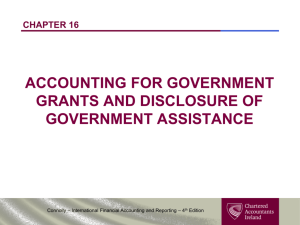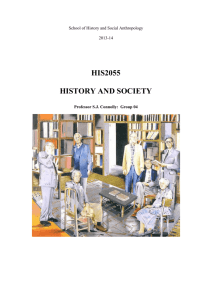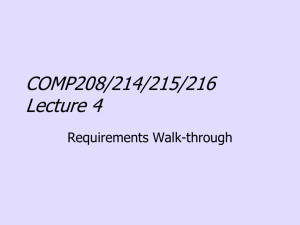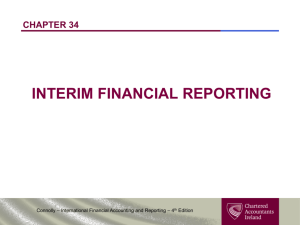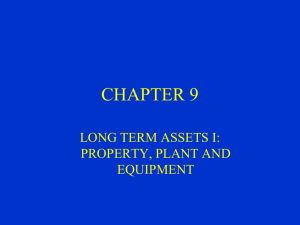Fair value model - Chartered Accountants Ireland
advertisement
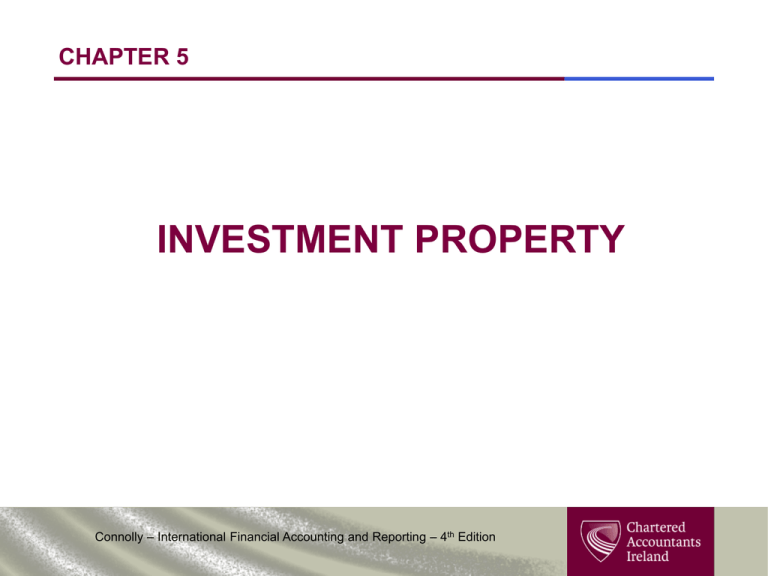
CHAPTER 5 INVESTMENT PROPERTY Connolly – International Financial Accounting and Reporting – 4th Edition 5.1 INTRODUCTION • • • Land and/or buildings held to earn rentals or for capital appreciation (or both) Not considered to be like most non-current assets as not acquired for ‘use’ in the traditional sense While recent events may have caused many to question the cliché ‘as safe as houses’, perhaps it’s not the investment property but the excessive related debt that is the problem Connolly – International Financial Accounting and Reporting – 4th Edition 5.2 IAS 40 INVESTMENT PROPERTY Definition: An investment property is property (land or a building – or part of a building – or both) that meets the following conditions: (a) the property is held to earn rentals or for capital appreciation or both Rather than for: (i) use in the production or supply of goods or services or for administrative purposes; or (ii) sale in the ordinary course of business. Connolly – International Financial Accounting and Reporting – 4th Edition Scope IAS 40 applies to all investment property including those: • • • held by a lessee under a finance lease held by a lessee under an operating lease where certain conditions are met held by a lessor and rented out under an operating lease See Chapter 5, Examples 5.1 and 5.2 Connolly – International Financial Accounting and Reporting – 4th Edition Table 5.2: When is property investment property? YES • • • • • Land held for LT capital appreciation rather than ST sale in the ordinary course of business; NO • Land held for a currently, undetermined future use; Building owned by the entity (or held by the entity under a finance lease (See Chapter 8)) and leased out under one or more operating leases; Building that is vacant but is held to be leased out under one or more operating leases ; and Property being constructed or developed for future use as investment property. • • • Property intended for sale in the ordinary course of business or in the process of construction or development for such sale (IAS 2 Inventories – See Chapter 11); Property being constructed or developed on behalf of third parties (IAS 11 Construction Contracts – See Chapter 12); Owner-occupied property (IAS 16 Property, Plant and Equipment – See Chapter 6); and Property leased to another entity under a finance lease (See Chapter 8). Connolly – International Financial Accounting and Reporting – 4th Edition Initial recognition and measurement • Investment property should be recognised initially as an asset when and only when: it is probable that the future economic benefits that are attributable to the investment property will flow to the entity; and the cost of the investment property can be measured reliably. • Investment property should initially be measured at cost. This includes the purchase price and any directly attributable expenditure (e.g. professional fees and property taxes). Connolly – International Financial Accounting and Reporting – 4th Edition Measurement after initial recognition • • • • An entity has the choice between the: Fair value model (not market value as per IAS 16 – See Chapter 6) Cost model The selected policy should be applied to all investment properties Fair value model Price at which the property could be exchanged between knowledgeable willing parties in an arm’s length transaction No depreciation Gains or losses should be recognised in arriving at profit or loss Cost model At cost less accumulated depreciation Connolly – International Financial Accounting and Reporting – 4th Edition Example 5.3: Applying the fair value model Floyd Limited commenced trading on 1 January 2012 and its non current assets at 31 December 2012 include two investment properties, Gilmore and Waters, that are let on an arm’s length basis to a third party. Floyd Limited applies the fair value model in accounting for investment properties, which are professionally valued for the first time on 31 December 2012. The valuation details are as follows: Property Cost €m Fair value €m Increase / (Decrease) €m Gilmore 210 345 135 Waters 390 280 (110) Requirement Explain and set out the journal entries necessary to record the movements between cost and far value in respect of each of the properties for the period ended 31 December 2012. Connolly – International Financial Accounting and Reporting – 4th Edition Example 5.3: Applying the fair value model Suggested Solution: Under the fair value model, changes in valuation are taken to the Statement of profit or loss and other comprehensive income – profit or loss: Gilmore DR Investment Property CR SPLOCI – P/L Gain on Investment Property €135m €135m Waters DR SPLOCI – P/L Loss on Investment Property CR Investment Property €110m €110m Connolly – International Financial Accounting and Reporting – 4th Edition Example 5.4: Applying the cost and fair value models ABC, a manufacturing company, purchases a property for €1m on 1 January 2012 for its investment potential. The land element of the cost is believed to be €400,000 and the buildings element is expected to have a useful life of 50 years. At 31 December 2012, local property indices suggest that the fair value of the property has risen to €1.1m. Requirement Show how the property would be presented in the financial statements as at 31 December 2012 if ABC adopts the: (i) Cost model; and (ii) Fair value model. Connolly – International Financial Accounting and Reporting – 4th Edition Example 5.4: Applying the cost and fair value models Suggested Solution: (i) Cost model Depreciation in the year is €600,000 = €12,000 50 SPLOCI – P/L = depreciation charge of €12,000; and SFP = property shown at NBV of €1,000,000 – €12,000 = €988,000. (ii) Fair value model SFP = property shown at fair value of €1.1m; and SPLOCI – P/L = gain of €0.1m representing the fair value adjustment. Connolly – International Financial Accounting and Reporting – 4th Edition Example Kerr Limited holds a building for its investment potential. This building originally cost €250,000. The fair value at 31 December 2012 was €500,000. At 31 December 2013 the fair value has risen to €600,000. The property was purchased on 1 January 2009 . Assume a useful economic life of 25 years. How should this change in fair value be accounted? (Ignore taxation) Connolly – International Financial Accounting and Reporting – 4th Edition Example: Suggested Solution Fair Value Model: • Carry at fair value (2012 = €500,000; 2013 = €600,000) • Gain of £100,000 to SPLOCI – P/L Cost Model: • Carry at depreciated historic cost • The property is five years old therefore NBV at the end of 2013 is £200,000 Connolly – International Financial Accounting and Reporting – 4th Edition TRANSFERS • • • From owner-occupied to investment property at fair value = any difference between IAS 16 carrying value and fair value of property is accounted for as an IAS 16 revaluation From investment property to owner-occupied or inventory = property’s deemed cost at date of change in use is its fair value From inventories to investment property at fair value = any difference between fair value and carrying value is recognised in arriving at profit or loss See Chapter 5, Table 5.2 Connolly – International Financial Accounting and Reporting – 4th Edition Disposals • • A gain or loss arising from the retirement or disposal of investment property is the difference between net disposal proceeds and the carrying amount of the asset Gain or loss is recognised in arriving at profit or loss Connolly – International Financial Accounting and Reporting – 4th Edition Disclosure • • • Fair value and cost models Fair value model Cost model Connolly – International Financial Accounting and Reporting – 4th Edition 5.3 COMPARING IAS 16 AND IAS 40 IAS 16 • • • • Cost or Market Value Models IAS 40 • • Different recognition rules for ‘first’ and ‘subsequent’ gains and losses Depreciation – cost and market value models Option to transfer % from RR to RE to offset depreciation • • Cost or Fair Value Models All gains and losses recognised in SPLOCI in arriving at operating profit no RR Depreciation – cost model only N/A Connolly – International Financial Accounting and Reporting – 4th Edition
